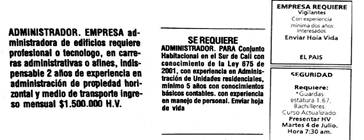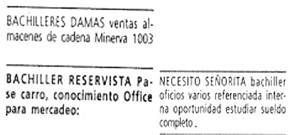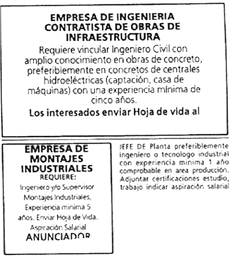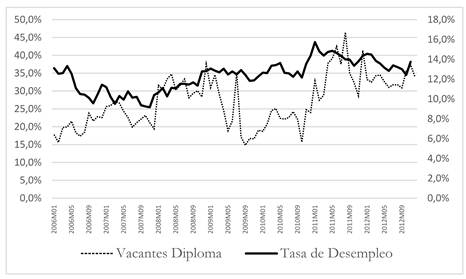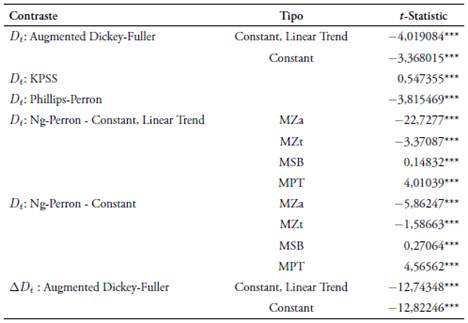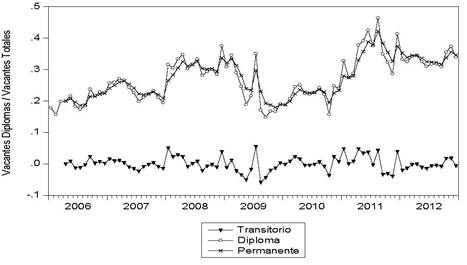Diplomas y desajuste educativo en Cali a partir de avisos clasificados
DOI:
https://doi.org/10.17533/udea.le.n86a07Palabras clave:
diplomas, credencialismo, clasificados, vacantes, raíz unitaria, descomposición Beveridge-Nelson.Resumen
Este artículo analiza el desajuste educativo en la ciudad de Cali, Colombia, a partir de la evolución de los requerimientos de diplomas reportados en los avisos clasificados publicados en El País, principal periódico de la ciudad. Para ello, se construye una serie de tiempo diferenciando entre aquellos avisos clasificados que exigen el diploma para acceder a un empleo y aquellos que no. Las pruebas muestran que esta serie tiene una raíz unitaria, por lo que se realiza una descomposición que permite estimar su componente permanente y transitorio. Nuestros resultados indican que el mercado laboral caleño es bastante credencialista, ya que se exige de forma regular el diploma para acceder a un puesto de trabajo. Esta situación incide sobre el emparejamiento en el mercado laboral y ahonda los desajustes educativos debido a que las empresas prefieren las credenciales de los trabajadores caleños.
Descargas
Citas
Abraham, Katharine G. (1983). “Structural/Frictional vs. Deficient Demand Unemployment: Some New Evidence”, The American Economic Review, Vol. 73, No. 4, pp. 708-724.
Álvarez, Andrés & Hofstetter, Marc (2013). “Cincuenta años de vacantes en Colombia. El caso de Bogotá (1960-2010)”, El Trimestre Económico, Vol. LXXX, No. 2, pp. 427-453.
Arango, Luis Eduardo (2013). “Puestos de trabajo vacantes según anuncios de la prensa escrita de las siete principales ciudades de Colombia”, Borradores de Economía, No. 793. Banco de la República, Colombia.
Arango, Luis Eduardo & Ríos, Ana María (2015). “Duración del desempleo en Colombia: género, intensidad de búsqueda y anuncios de vacantes”, Borradores de Economía, No. 866. Banco de la República, Colombia.
Arrow, Kennet (1973). “Higher Education as a Filter”, Journal of Public Economics, Vol. 2, No. 3, pp. 193-216.
Becker, Gary (1964). Human Capital. N.Y.: NBER, Columbia University press.
Beveridge, Stephen & Nelson, Charles (1981). “A new approach to the decomposition of economic time series into permanent and transitory components with particular attention to measurement of the business cycle”, Journal of Monetary Economics, Vol. 7, No. 2, pp. 151-174.
Castellar, Carlos & Uribe, José Ignacio (2004). “Capital humano y señalización: evidencia para el área metropolitana de Cali, 1988-2000”, Revista Sociedad y Economía, Vol. 6, pp. 51-79.
Castillo Caicedo, Maribel (2007). “Desajuste educativo por regiones en Colombia: ¿Competencias por salarios o por puestos de trabajo?”, Cuadernos de Economía, Vol. 26, No. 46, pp. 107-145. El País (2015, 7 de junio). Profesionales de Papel. El País, A10 y A11.
Hylleberg, Svend; Engle, Robert; Granger, Clive & Yoo, B.S. (1990). “Seasonal Integration and Cointegration”, Journal of Econometrics, Vol. 44, No. 1-2, pp. 215-238.
Kendall, Maurice George & Ord, J.K. (1990). Time Series (3rd Ed.). Londres: Edward Arnold.
Lytras, Demetra P.; Feldpausch, Roxanne M. & Bell, William R. (2007). “Determining Seasonality: AComparison of Diagnostics from X-12-ARIMA”, Working paper. United States Census Bureau.
Mora, Jhon James (2003). “Screening and sheepskin effects in Colombia”, Colombian Economic Journal, Vol. 1 No. 1, pp. 95-108.
Mora, Jhon James (2008). “Sobre-educación en el mercado laboral colombiano”, Revista de Economía Institucional, Vol. 10, No. 19, pp. 293-309.
Mora, Jhon James & Arcila, Andrés Mauricio (2014). “Brechas Salariales por Etnia y Ubicación Geográfica en Santiago de Cali”, Revista de Métodos Cuantitativos para la Economía y la Empresa, Vol. 18, pp. 34-83.
Mora, Jhon James & Caicedo, Carolina (2013). ¿Igualdad Salarial entre hombres y mujeres en Santiago de Cali? De la legislación a la realidad. Bogotá D.C.: Programa de las Naciones Unidas para el Desarrollo (PNUD).
Mora, Jhon James & Muro, Juan (2015). “On the size of sheepskin effects: A meta-analysis”, Economics - The Open-Access, Open-Assessment E-Journal, Vol. 9, 2015-37, pp. 1-18.
Mora, Jhon James & Pérez, Lisset (2014). “La calidad del empleo en la población afrodescendiente colombiana: una aproximación desde la ubicación geográfica de las comunas”, Revista de Economía del Rosario, Vol. 17, No. 2, pp. 117-149.
Mora, Jhon James; Caicedo, Carolina & González, Carlos Giovanni (2015). “La Duración del Desempleo de los Jóvenes y los “ninis” en Cali”. Icesi Economics Working Paper, No. 5. Departamento de Economía, Universidad Icesi, Colombia.
Mora, Jhon James; González, Natalia; Zuluaga, Blanca; Gómez, Juan Carlos (2004). “Las Ganancias de Señalizar en el Mercado Laboral en Cali”, Estudios Gerenciales. Journal of Management and Economics for Iberoamerica, Vol. 20, No. 92, pp. 105-128.
Moreno, José Luis (1998). Economía de la Educación. Madrid: Ed. Pirámide.
Psacharopoulos, George (1979). “On the weak versus the strong version of the screening hypothesis”, Economics letters, Vol. 4, No. 2, pp. 181-185.
Pierce, David A. (1978). “Seasonal Adjustment When Both Deterministic and Stochastic Seasonality are Present”. En: Zellner, Arnold (Ed.), Seasonal Analysis of Economic Time Series (pp. 242-269). Washington, DC: U.S. Department of Commerce, Bureau of the Census.
Riley, Jhon (1976). “Information, Screening and Human Capital”, American Economic Review, Vol. 66, No. 2, pp. 254-260.
Schultz, Theodore (1960). “Capital Formation by Education”, Journal of Political Economy, Vol 68, No. 6, pp. 571-583.
Spence, Michael A. (1973). “Job Market Signalling”, Quarterly Journal of Economics, Vol. 87, No. 3, pp. 355-374.
Stiglitz, Joseph (1975) “The theory of screening, education and the distribution of income”, American Economic Review, Vol. 65, No. 3, pp. 283-300.
Publicado
Cómo citar
Número
Sección
Licencia
Derechos de autor 2017 Jhon James Mora, Andres Cendales, Carolina Caicedo

Esta obra está bajo una licencia internacional Creative Commons Atribución-NoComercial-CompartirIgual 4.0.
Este sitio web, por Universidad de Antioquia, está licenciado bajo una Creative Commons Attribution License.
Los autores que publiquen en esta revista aceptan que conservan los derechos de autor y ceden a la revista el derecho de la primera publicación, con el trabajo registrado con una Licencia de Atribución-NoComercial-CompartirIgual de Creative Commons, que permite a terceros utilizar lo publicado siempre que mencionen su autoría y a la publicación original en esta revista.
Los autores pueden realizar acuerdos contractuales independientes y adicionales para la distribución no exclusiva de la versión del trabajo publicada en la revista (por ejemplo, incluirla en un repositorio institucional o publicarla en un libro) siempre que sea con fines no comerciales y se reconozca de manera clara y explícita que el artículo ha sido originalmente publicado en esta revista.
Se permite y recomienda a los autores publicar sus artículos en Internet (por ejemplo, en páginas institucionales o personales), ya que puede conducir a intercambios provechosos y a una mayor difusión y citación de los trabajos publicados.







